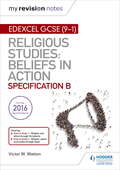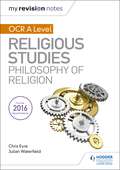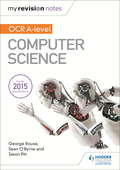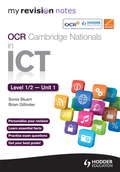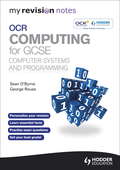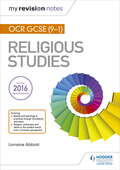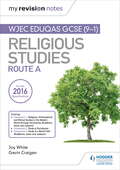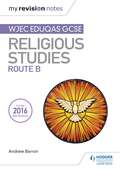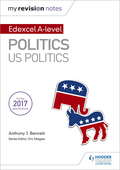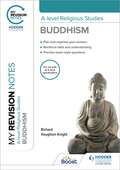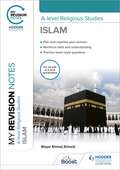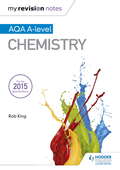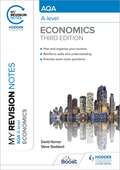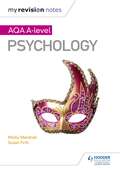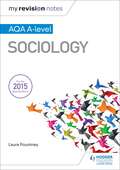- Table View
- List View
My Revision Notes CCEA GCSE Religious Studies: Christianity through a Study of the Gospel of Mark
by Mary NethercottTarget success in CCEA GCSE Religious Studies with this proven formula for effective, structured revision. Key content coverage is combined with exam-style tasks and practical tips to create a revision guide that students can rely on to review, strengthen and test their knowledge.With My Revision Notes, every student can:- Get to grips with Bible text with all the passages from the specification included - Plan and manage a successful revision programme using the topic-by-topic planner- Consolidate subject knowledge by working through clear and focused content coverage- Test understanding and identify areas for improvement with regular exam-style tasks and answers- Improve exam technique through practice questions, sample answers and guidance
My Revision Notes Edexcel Religious Studies for GCSE (9-1) (9-1) (9-1) (9-1): Catholic Christianity (Specification A): Faith and Practice in the 21st Century
by Victor W. WattonExam board: EdexcelLevel: GCSESubject: Religious StudiesFirst teaching: September 2016First exams: Summer 2018Target success in Edexcel GCSE A Religious Studies with this proven formula for effective, structured revision; key content coverage is combined with exam-style tasks and practical tips to create a revision guide you can rely on to review, strengthen and test their knowledge.With My Revision Notes you can:- Plan and manage a successful revision programme using the topic-by-topic planner- Consolidate subject knowledge by working through clear and focused content coverage- Test understanding and identify areas for improvement with regular 'Now Test Yourself' tasks and answers- Improve exam technique through practice questions, expert tips and examples of typical mistakes to avoid
My Revision Notes Edexcel Religious Studies for GCSE (9-1): Area 1 Religion and Ethics through Christianity, Area 2 Religion, Peace and Conflict through Islam
by Victor W. WattonExam Board: EdexcelLevel: GCSESubject: Religious StudiesFirst Teaching: September 2016First Exam: Summer 2018Target success in Edexcel GCSE B Religious Studies with this proven formula for effective, structured revision; key content coverage is combined with exam-style tasks and practical support to create a revision guide you can rely on to review, strengthen and test their knowledge.With My Revision Notes you can:- Plan and manage a successful revision programme using the topic-by-topic planner- Consolidate subject knowledge by working through clear and focused content coverage- Test understanding and identify areas for improvement with regular 'Now Test Yourself' tasks and answers- Improve exam technique through example questions and expert supportCovering:Area 1 Religion and Ethics through ChristianityArea 2 Religion, Peace and Conflict through Islam
My Revision Notes OCR A Level Religious Studies: Developments in Christian Thought
by Chris Eyre Julian WaterfieldTarget success in OCR A Level Religious Studies with this proven formula for effective, structured revision; key content coverage is combined with exam-style tasks and practical tips to create a revision guide you can rely on to review, strengthen and test their knowledge.With My Revision Notes you can:- Plan and manage a successful revision programme using the topic-by-topic planner.- Consolidate subject knowledge by working through clear and focused content coverage.- Test understanding and identify areas for improvement with regular 'Now Test Yourself' tasks and answers.- Improve exam technique through practice questions, expert tips and examples of typical mistakes to avoid.
My Revision Notes OCR A Level Religious Studies: Philosophy of Religion
by Chris Eyre Julian WaterfieldExam board: OCRLevel: A-levelSubject: Religious Studies First teaching: September 2016First exams: Summer 2017Target success in OCR A Level Religious Studies with this proven formula for effective, structured revision; key content coverage is combined with exam-style tasks and practical tips to create a revision guide you can rely on to review, strengthen and test their knowledge.With My Revision Notes you can:- Plan and manage a successful revision programme using the topic-by-topic planner- Consolidate subject knowledge by working through clear and focused content coverage- Test understanding and identify areas for improvement with regular 'Now Test Yourself' tasks and answers- Improve exam technique through practice questions, expert tips and examples of typical mistakes to avoid
My Revision Notes OCR A Level Religious Studies: Religion and Ethics
by Chris Eyre Julian WaterfieldExam board: OCRLevel: A-levelSubject: Religious Studies First teaching: September 2016First exams: Summer 2017Target success in OCR A Level Religious Studies with this proven formula for effective, structured revision; key content coverage is combined with exam-style tasks and practical tips to create a revision guide you can rely on to review, strengthen and test their knowledge.With My Revision Notes you can:- Plan and manage a successful revision programme using the topic-by-topic planner- Consolidate subject knowledge by working through clear and focused content coverage- Test understanding and identify areas for improvement with regular 'Now Test Yourself' tasks and answers- Improve exam technique through practice questions, expert tips and examples of typical mistakes to avoid
My Revision Notes OCR A level Computer Science
by George Rouse Sean O'Byrne Jason PittWith My Revision Notes you can: Take control of your revision: plan and focus on the areas where you need to improve your knowledge and understanding with advice, summaries and notes from expert authors Achieve your potential by applying computing terms accurately with the help of definitions and key words on all topicsImprove your exam skills by tackling exam-style and self-testing questions
My Revision Notes OCR Cambridge Nationals in ICT Levels 1 / 2 Unit 1 Understanding Computer Systems
by Sonia Stuart Brian GillinderUnlock your full potential with this revision guide which focuses on the key content and skills you need to know.
My Revision Notes OCR Computing for GCSE Computer Systems and Programming
by George Rouse Sean O'ByrneUnlock your full potential with this revision guide which focuses on the key content and skills you need to know.With My Revision Notes for OCR Computing for GCSE, which perfectly matches the theory units of the specification, you can: Take control of your revision: plan and focus on the areas you need to revise, with advice, summaries and notes from authors Sean O'Byrne and George Rouse Show you fully understand key topics, by using specific case studies to add depth to your knowledge of computing issues and processes Apply computing terms accurately with the help of definitions and key words on all topics Improve your skills to tackle specific exam questions with the help of self-testing and exam-style questions and answers Get exam-ready with last-minute quick quizzes at www.hodderplus.co.uk/myrevisionnotes
My Revision Notes OCR GCSE (9-1) Religious Studies
by Lorraine AbbottTarget success in OCR GCSE Religious Studies with this proven formula for effective, structured revision; key content coverage is combined with exam-style tasks and practical tips to create a revision guide you can rely on to review, strengthen and test their knowledge.With My Revision Notes you can:- Plan and manage a successful revision programme using the topic-by-topic planner- Consolidate subject knowledge by working through clear and focused content coverage- Test understanding and identify areas for improvement with regular 'Now Test Yourself' tasks (with answers online)- Improve exam technique through practice questions and expert tips
My Revision Notes WJEC Eduqas GCSE (9-1) Religious Studies Route A: Covering Christianity, Buddhism, Islam and Judaism
by Gavin Craigen Joy WhiteTarget success in WJEC Eduqas GCSE Religious Studies Route A with this proven formula for effective, structured revision; key content coverage is combined with exam-style tasks and practical tips to create a revision guide you can rely on to review, strengthen and test their knowledge.With My Revision Notes you can:- Plan and manage a successful revision programme using the topic-by-topic planner- Consolidate subject knowledge by working through clear and focused content coverage- Test understanding and identify areas for improvement with regular 'Now Test Yourself' tasks and answers- Improve exam technique through practice questions, expert tips and examples of typical mistakes to avoid
My Revision Notes WJEC Eduqas GCSE Religious Studies Route B
by Andrew BarronTarget success in WJEC Eduqas GCSE Religious Studies Route B with this proven formula for effective, structured revision; key content coverage is combined with exam-style tasks and practical tips to create a revision guide you can rely on to review, strengthen and test their knowledge.With My Revision Notes you can:- Plan and manage a successful revision programme using the topic-by-topic planner- Consolidate subject knowledge by working through clear and focused content coverage- Test understanding and identify areas for improvement with regular 'Now Test Yourself' tasks and answers- Improve exam technique through practice questions, expert tips and examples of typical mistakes to avoid
My Revision Notes WJEC GCSE Religious Studies: Unit 2 Rel And Eth Themes Epub
by Gavin Craigen Joy WhiteTarget success in WJEC GCSE Religious Studies with this proven formula for effective, structured revision; key content coverage is combined with exam-style tasks and practical tips to create a revision guide you can rely on to review, strengthen and test their knowledge.With My Revision Notes you can:- Plan and manage a successful revision programme using the topic-bytopic planner.- Consolidate subject knowledge by working through clear and focused content coverage.- Test understanding and identify areas for improvement with regular 'Now Test Yourself' tasks and answers.- Improve exam technique through practice questions, expert advice and examples of typical mistakes to avoid.
My Revision Notes: Edexcel AS/A-level Politics: US Politics
by Anthony J BennettTarget success in politics with this proven formula for effective, structured revision; key content coverage is combined with exam-style tasks and practical tips to create a revision guide that students can rely on to review, strengthen and test their knowledge.With My Revision Notes, every student can:- Plan and manage a successful revision programme using the topic-by-topic planner- Consolidate subject knowledge by working through clear and focused content coverage- Test understanding and identify areas for improvement with regular 'Now Test Yourself' tasks and answers- Improve exam technique through practice questions, expert tips and examples of typical mistakes to avoid- Get exam ready with extra quick quizzes and answers to the practice questions available online
My Revision Notes: A-level Religious Studies Buddhism
by Richard Houghton-KnightTarget exam success with My Revision Notes. Our updated approach to revision will help students learn, practise and apply their skills and understanding. Coverage of key content is combined with practical study tips and effective revision strategies to create a revision guide students can rely on to build both knowledge and confidence.My Revision Notes: A-level Religious Studies Buddhism will help students to:- Plan and manage a successful revision programme using the topic-by-topic planner- Consolidate your knowledge by working through clear and focused content coverage- Test understanding and identify areas for improvement with regular tasks and answers- Improve exam technique through practice questions, expert tips and examples of typical mistakes to avoid
My Revision Notes: A-level Religious Studies Islam
by Waqar Ahmad AhmediTarget exam success with My Revision Notes. Our updated approach to revision will help students learn, practise and apply their skills and understanding. Coverage of key content is combined with practical study tips and effective revision strategies to create a revision guide students can rely on to build both knowledge and confidence.My Revision Notes: A-level Religious Studies Islam will help students to:- Plan and manage a successful revision programme using the topic-by-topic planner- Consolidate your knowledge by working through clear and focused content coverage- Test understanding and identify areas for improvement with regular tasks and answers- Improve exam technique through practice questions, expert tips and examples of typical mistakes to avoid
My Revision Notes: AQA A Level Biology
by Mike BoyleExam Board: AQALevel: AS/A-levelSubject: BiologyFirst Teaching: September 2015First Exam: June 2016With My Revision Notes: AQA A level Biology you can:- Manage your own revision with step-by-step support from experienced teacher and examiner Mike Boyle- Apply biological terms accurately with the help of definitions and key words- Plan and pace your revision with the revision planner- Test understanding with questions throughout the book- Get exam ready with last minute quick quizzes available on the Hodder Education website
My Revision Notes: AQA A Level Business
by Neil JamesTarget success in AQA A-level Business with this proven formula for effective, structured revision; key content coverage is combined with exam-style tasks and practical tips to create a revision guide that students can rely on to review, strengthen and test their knowledge.With My Revision Notes every student can:- Plan and manage a successful revision programme using the topic-by-topic planner- Consolidate subject knowledge by working through clear and focused content coverage- Test understanding and identify areas for improvement with regular 'Now Test Yourself' tasks and answers- Improve exam technique through practice questions, expert tips and examples of typical mistakes to avoid- Get exam ready with extra quick quizzes and answers to the practice questions available online
My Revision Notes: AQA A Level Chemistry
by Rob KingWith My Revision Notes: AQA A Level Chemistry you can:- Manage your own revision with step-by-step support from experienced teacher and examiner Rob King- Apply biological terms accurately with the help of definitions and key words- Plan and pace your revision with the revision planner- Test understanding with questions throughout the book- Get exam ready with last minute quick quizzes available on the Hodder Education website
My Revision Notes: AQA A Level Economics Third Edition
by David Horner Steve StoddardTarget exam success with My Revision Notes. Our updated approach to revision will help you learn, practise and apply your skills and understanding. Coverage of key content is combined with practical study tips and effective revision strategies to create a guide you can rely on to build both knowledge and confidence. My Revision Notes: AQA A-level Economics: Third Edition will help you:- Plan and manage your revision with our topic-by-topic planner and exam breakdown introduction- Develop your subject knowledge by making links between topics for more in-depth exam answers- Improve subject-specific skills with an exam skills checkbox at the end of each chapter- Avoid common mistakes and enhance your exam answers with examiner tips- Practise and apply your skills and knowledge with exam-style questions and frequent questions with answer guidance online- Understand key terms you will need for the exam with user-friendly definitions and a glossary- Build quick recall with bullet-pointed summaries at the end of each chapter
My Revision Notes: AQA A Level Psychology
by Molly Marshall Susan FirthManage your own revision with step-by-step support from experienced teacher and examiner Molly Marshall. Use a selection of examples activities to improve your understanding of psychological concepts. Apply psychological terms accurately with the help of definitions and key words.- Plan and pace your revision with the revision planner- Use the expert tips to clarify key points- Avoid making typical mistakes with expert advice- Test yourself with end-of-topic questions and answers and tick off each topic as you complete it- Get exam ready with last minute quick quizzes at www.hodderplus.co.uk/myrevisionnotes
My Revision Notes: AQA A Level Sociology
by Laura PountneyTarget success in sociology with this proven formula for effective, structured revision; key content coverage is combined with exam-style tasks and practical tips to create a revision guide that students can rely on to review, strengthen and test their knowledge.With My Revision Notes, every student can:- Plan and manage a successful revision programme using the topic-by-topic planner- Consolidate subject knowledge by working through clear and focused content coverage- Test understanding and identify areas for improvement with regular 'Now Test Yourself' tasks and answers- Improve exam technique through practice questions, expert tips and examples of typical mistakes to avoid- Get exam ready with extra quick quizzes and answers to the practice questions available onlineMy Revision Notes AQA A-level Sociology includes all compulsory topics as well as the optional topics Families and households and Beliefs in society.
My Revision Notes: AQA A-Level Design and Technology: Fashion and Textiles
by Kate Bush Julie DrakeExam board: AQA Level: A-levelSubject: Design and TechnologyFirst teaching: September 2017First exams: Summer 2019 Target success in AQA A-level Fashion and Textiles with our proven formula for effective, structured revision; key content coverage of both papers - Technical Principles and Designing and Making Principles - is combined with exam-style tasks and practical tips to create a revision guide that students can rely on to review, strengthen and test their knowledge.With My Revision Notes, every student can:- Plan and manage a successful revision programme using the topic-by-topic planner- Consolidate subject knowledge by working through clear and focused content coverage- Improve exam technique, including interpretation and application, through practice questions, sample answers and exam tips
My Revision Notes: AQA A-level Business: Third Edition
by Neil James George VlachonikolisOur updated approach to revision will help you learn, practise and apply your skills and understanding. Coverage of key content is combined with practical study tips and effective revision strategies to create a guide you can rely on to build both knowledge and confidence. My Revision Notes: AQA A-level Business: Third Edition will help you:- Plan and manage your revision with our topic-by-topic planner and exam breakdown introduction- Develop your subject knowledge by making links between topics for more in-depth exam answers- Improve subject-specific skills with an exam skills checkbox at the end of each chapter- Avoid common mistakes and enhance your exam answers with examiner tips- Practise and apply your skills and knowledge with exam-style questions and frequent questions with answer guidance online- Understand key terms you will need for the exam with user-friendly definitions and a glossary- Build quick recall with bullet-pointed summaries at the end of each chapter
My Revision Notes: AQA A-level Economics
by David Horner Steve StoddardManage your own revision with step-by-step support from experienced teachers and examiners David Horner and Steve Stoddard. Use specific examples to place economic theory in a real-world context. With this AQA A-level Economics, apply economic terms accurately with the help of definitions and key words.- Plan and pace your revision with the revision planner- Use the expert tips to clarify key points- Avoid making typical mistakes with expert advice- Test yourself with end-of-topic questions and answers and tick off each topic as you complete it- Get exam ready with last minute quick quizzes at www.hoddereducation.co.uk/myrevisionnotes


